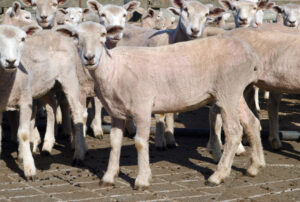It’s quality and supply, not diminished demand, which is pushing lamb prices down as buyers start to be selective. Team this with reports of processors being booked out for “some months”, and the next crop of lambs being not that far away, there’s little to show that lamb will lift at the moment, despite its usual winter peak.
We read last week that lamb slaughter was up nearly 5% year-on-year for the first quarter of 2023 according to ABS, yet another indicator of lambs held over from the previous season. And according to Meat & Livestock Australia, combined sheep, lamb, and cattle slaughter was at its highest level last week since 2002.
Some historical perspective is always helpful. We’ll start with the Eastern States Trade Lamb Indicator (ESTLI), which averaged 586¢/kg last week. This is the same figure the ESTLI averaged for the same week in 2016. Comparing the 2022/23 financial year to the 2015/16 year, however, the ESTLI is currently averaging 717¢/kg, well above the 560¢/kg it averaged back then. Prices of late are more closely aligned for the time of year with the 2016/17 and 2018/19 years – when we were also in the rebuild and before the last drought started to bite.
If we look at the current price year-on-year, however, it is a significant drop – down 25%, and even further below (27%) the five-year average. The ESTLI has been on a steady decline for the month of May and has fallen every week for the past seven weeks. Comparatively, the five-year average generally rises for that period – and so for the month of May. The restocker price in the east has been faring even worse and is sitting at 44% below its year-ago level, and similar to that beneath the five-year-average. We have to look back to 2013 to find the last time that price was lower at this time of year.
ABS gave us higher slaughter figures for the first three months of the year, and looking at the weekly MLA figures in the east this increase has continued. The average weekly lamb slaughter for the year-to-date is at its highest level since 2018, and the latest weekly figure was 14% higher year-on-year, 11% above the five-year average. Again, it was back in 2018 that the slaughter volume for the corresponding week was higher.
The heavy lamb price on the other hand is supporting the reports of a quality-driven demand cycle and processors at capacity. While it has fallen along with the other indicators, the eastern states’ price has taken less of a hit. At 659¢/kg last week, it was 16% lower year-on-year, and 18% under the five-year average. For the 2022/23 year, heavy lambs average 753¢/kg, Prices for the month of May sit well above 2017/18 levels, and many years before that. It too has been on the decline in recent weeks, when historically it is on the rise, but it has been trading at a premium to the ESTLI for the past 10 weeks. If we look at the long-term average, the ESTLI usually trades at a 5¢/kg premium to the heavy price for that period. This year, the heavy indicator has been operating at a nearly 10% premium to the ESTLI.
What does it mean?
The heavy lamb premium is a silver lining for the industry in more ways than one. It is showing the demand for the finished product remains as strong as ever, with processor capacity and producers’ ability to finish stock hindering the volume that is being produced. Slaughter and continued lamb numbers show us a maturing flock rebuild means fewer restockers on the market. This equates to any traditional winter price lift being unlikely but shows us that demand for the end product hasn’t gone anywhere, we just need to get it there.
Have any questions or comments?
Key Points
- ESTLI is sitting at 27% below the five-year average, as slaughter volumes continue to rise.
- Processors at capacity and lesser quality lambs allow buyers able to be selective.
- Heavy lamb is operating at a 10% premium to the Eastern States Trade Lamb Indicator.
Click on figure to expand
Click on figure to expand
Click on figure to expand
Data sources: MLA, Mecardo















